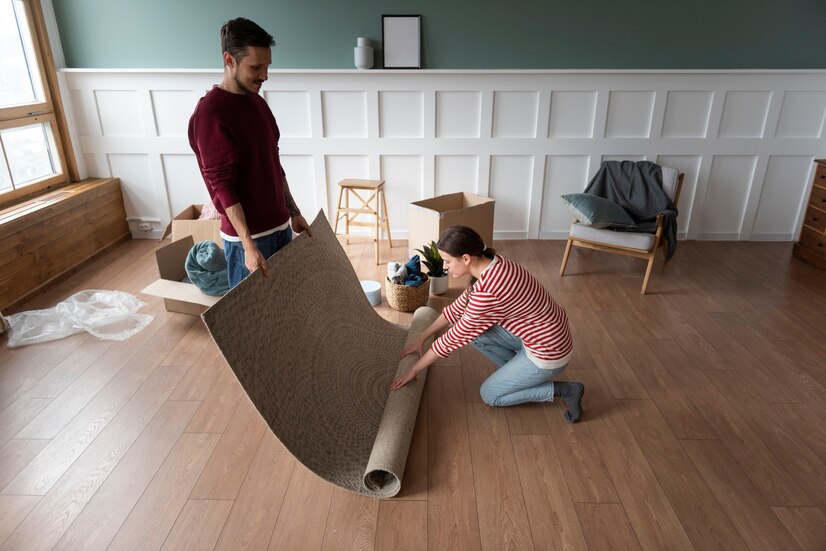In today’s fast-paced world, flooring selection has a significant impact on a space’s durability, functionality, and aesthetics. Sheet vinyl flooring is one choice that has endured over time while changing with fashion and technological advancements. It is a common and adaptable flooring option for both commercial and residential settings. To help you choose the ideal option for your house or place of business, we’ll go over the advantages of sheet vinyl, the available styles, and some practical installation advice in this post.
What is Sheet Vinyl Flooring?
Synthetic flooring materials like sheet vinyl are composed of layers of polyvinyl chloride (PVC) reinforced with additional materials to give them flexibility and strength. They are perfect for covering large areas with few seams because they are usually sold in large, continuous sheets rather than tiles or planks.
Modern sheet vinyl flooring has evolved with high-end designs, increased durability, and eco-friendly options, while older styles may bring back memories of antiquated flooring.
Advantages of Sheet Vinyl Flooring
Sheet vinyl is still a popular option for many business owners and homeowners for a number of reasons. The main advantages are as follows:
1. Affordability
One of the biggest advantages of sheet vinyl flooring is its affordability. It provides a cost-effective alternative to materials like hardwood, stone, or ceramic tiles, making it an ideal option for budget-conscious renovations.
2. Water Resistance
Sheet vinyl is highly water-resistant, which makes it perfect for areas prone to moisture, such as bathrooms, kitchens, and laundry rooms. Since it’s installed as a large sheet, it reduces the risk of water seeping through seams, a common issue with other flooring types.
3. Durability
Thanks to its multi-layered construction, modern sheet vinyl is incredibly durable. It resists scratches, stains, and dents, making it suitable for high-traffic areas. Depending on the thickness and quality, some vinyl sheets can last up to 20 years or more with proper care.
4. Comfort and Sound Insulation
Sheet vinyl is softer underfoot compared to harder materials like tiles or wood. It also provides a level of sound insulation, reducing noise when walking on it. Some vinyl sheets come with additional cushioning layers that enhance comfort, making it a great option for spaces where you’ll spend a lot of time standing.
5. Ease of Maintenance
Vinyl is extremely easy to clean and maintain. Regular sweeping and occasional mopping with mild detergents are enough to keep it looking pristine. It is also resistant to mold and mildew, further reducing the need for intense cleaning efforts.
6. Variety of Styles and Designs
Modern sheet vinyl flooring comes in a wide array of designs, from wood-like finishes to marble and stone imitations. It can mimic the look of more expensive materials while offering a fraction of the price and easier upkeep. This versatility in design makes it easy to fit into any décor, whether you prefer a classic, contemporary, or rustic look.
Popular Styles of Sheet Vinyl Flooring
With so many options, it can be overwhelming to choose the perfect design for your space. Here are a few of the most well-liked sheet vinyl designs:
1. Wood-Look Vinyl
Vinyl sheets that imitate the appearance of hardwood flooring are highly sought after due to their ability to replicate natural grains and textures. With improved printing technologies, it’s often difficult to distinguish between real wood and vinyl alternatives at first glance. Wood-look vinyl is perfect for spaces where the look of hardwood is desired but where moisture resistance or durability is a concern.
2. Stone and Tile Patterns
For a sleek, high-end look, sheet vinyl can also be designed to resemble natural stone or ceramic tiles. This option allows you to enjoy the luxury and elegance of materials like marble, granite, or slate without the hefty price tag or intensive maintenance.
3. Geometric and Abstract Patterns
If you want to make a bold statement, there are plenty of geometric and abstract designs available in sheet vinyl. From vintage patterns to modern, edgy designs, these options can add a touch of personality to any room.
4. Solid and Decorative Colors
Sometimes, simplicity is best. Solid color sheet vinyl is ideal for spaces where you want a clean, minimalist look. You can also find decorative styles with subtle patterns or textures that add just enough interest without overwhelming the space.
Installation Tips for Sheet Vinyl Flooring
Because installing sheet vinyl is so simple, even though hiring a professional installer is always an option, a lot of people choose to do their own installation. Here are some suggestions to make sure your DIY flooring installation goes well if you decide to do it yourself:
1. Prepare the Subfloor
A smooth, clean subfloor is crucial for a successful vinyl installation. Make sure the surface is level, dry, and free of debris. Any bumps or imperfections in the subfloor can affect the appearance and longevity of the vinyl.
2. Use the Right Adhesive
Depending on the type of sheet vinyl you choose, you may need to use adhesive to secure the flooring in place. Some vinyl sheets come with a peel-and-stick backing, while others require glue. Be sure to follow the manufacturer’s instructions for the correct type of adhesive.
3. Allow for Expansion
Vinyl expands and contracts with temperature changes, so it’s essential to leave a small gap (usually around 1/8 inch) between the edge of the vinyl and the walls. This ensures that the flooring can move naturally without buckling.
4. Carefully Measure and Cut
Measure the area of the room accurately and cut the vinyl sheet to size, allowing for extra material around the edges for trimming. When cutting around fixtures or corners, take your time to ensure a precise fit.
5. Seal the Seams
If you’re installing vinyl in a larger room that requires multiple sheets, be sure to seal the seams properly to prevent moisture from seeping through. Some vinyl floors come with seam-sealing kits to make this process easier.
Caring for Your Sheet Vinyl Flooring
Maintaining and caring for your vinyl flooring properly will help it last longer. The following general maintenance advice:
- Sweep and mop regularly: Regularly sweep or vacuum your floor to remove dust and debris, and mop it with a damp mop and mild detergent as needed.
- Avoid abrasive cleaners: Harsh chemicals or abrasive scrubbing can damage the surface of vinyl, so stick to gentle cleaners.
- Protect against scratches: Use furniture pads to protect the floor from scratches caused by heavy furniture. Be mindful of dragging sharp objects across the surface.
Is Sheet Vinyl the Right Choice for You?
Sheet vinyl flooring is a viable option if you’re looking for a reasonably priced, long-lasting, and fashionable flooring solution. Vinyl offers several advantages that make it a wise choice for contemporary homes and businesses, whether you need a water-resistant solution for a bathroom, a comfortable surface for a busy living area, or a more durable alternative to pair with an epoxy floor coating kit in high-traffic areas like garages or workshops.
You can choose a style that improves the appearance and usability of your space with confidence if you know what to look for, how to install it, and how to take care of this adaptable material.



